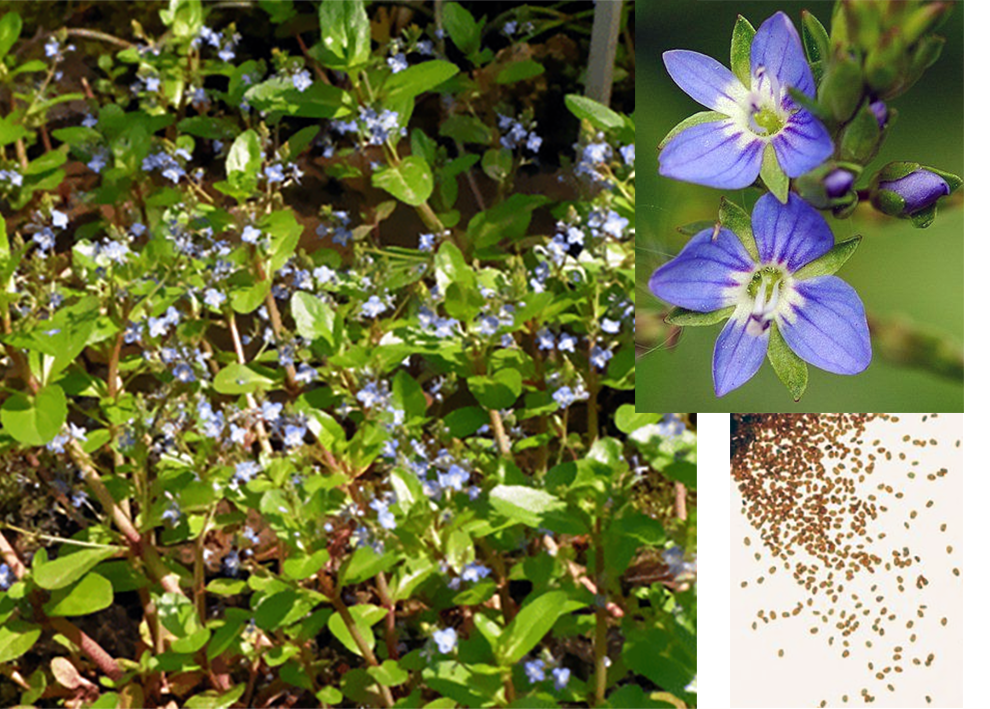 The image, above, shows the full Brooklime plant (Veronica
The image, above, shows the full Brooklime plant (Veronicabeccabunga) including stem, leaves and flowers..
|
Common Name: Brooklime |
| Scientific Name: Veronica beccabunga |
|
Other Names: Echium amoenum, Common borage, Cool-tankard, Tailwort, European Speedwell and Starflower |
| Family: Scrophulariaceae |
| Range: Europe, incl Britain, from Norway south and east to N. Africa, temperate Asia to Japan and Himalayas |
Physical Characteristics Veronica beccabunga is a hardy Perennial plant, growing to 60cm (2 ft) in height. It is hardy to zone 5 and is not frost tender. The plant flowers from May to September and the seeds ripen from July to September. The flowers are hermaphrodite and are pollinated by bees and flies. The flowers are self-fertile. Borage is noted as a wildlife attractant.
Veronica beccabunga is a hardy Perennial plant, growing to 60cm (2 ft) in height. It is hardy to zone 5 and is not frost tender. The plant flowers from May to September and the seeds ripen from July to September. The flowers are hermaphrodite and are pollinated by bees and flies. The flowers are self-fertile. Borage is noted as a wildlife attractant.
|
| Edible Parts: Leaves |
|
|
|
|
Welcome to the summary page for FabulousFusionFood's Wild Food guide to Brooklime along with all the Brooklime containing recipes presented on this site, with 0 recipes in total.
This is a continuation of an entire series of pages that will, I hope, allow my visitors to better navigate this site. As well as displaying recipes by name, country and region of origin I am now planning a whole series of pages where recipes can be located by meal type and main ingredient. This page gives a listing of all the Cornish recipes added to this site.
These recipes, all contain Brooklime as a major wild food ingredient.
Brooklime, Veronica beccabunga is a succulent herb belonging to the Scrophulariaceae (figwort) family. It is a native of Europe, North Africa and Asia that grows in streams, ditches, ponds as well as wet patches in meadows. It has smooth spreading branches, blunt oblong leaves and small bright blue or pink flowers which are produced in May through to September.
The leaves are edible and somewhat reminiscent of a bitter watercress. If lightly salted for ten minutes and then briefly boiled in salted water they become more palatable and can be used as a vegetable. It's also possible to use the chopped leaves sparingly in sandwiches and salads, but they are very pungent. Due to their pungent nature, they are not particularly palatable (despite being nutritious) and are best cooked with other strongly-flavoured greens.
[2]. Huxley, A. The New RHS Dictionary of Gardening. 1992
[3]. Tanaka, T. Tanaka's Cyclopaedia of Edible Plants of the World.
[4]. Lim T.K. Edible Medicinal And Non-Medicinal Plants, Vols 1–8.
[5]. Thomas, G. S. Perennial Garden Plants
[6]. Milner, E. Trees of Britain and Ireland
[7]. Rose, F. & O'Reilly, C. The Wild Flower Key (Revised Edition) – How to identify wild plants, trees and shrubs in Britain and Ireland
[8]. Streeter, D. & Garrard, I. The Wild Flowers of the British Isles
[9]. Clapham, A.R.; Tutin, T.G. & Moore, D.M. Flora of the British Isles
[10]. Phillips, R. Mushrooms
[10]. Phillips, R. Mushrooms
[11]. Jordan, P. & Wheeler, S. The Complete Book of Mushrooms: An Illustrated Encyclopedia of Edible Mushrooms
[12]. Bunker, F.; Brodie, J.A.; Maggs, C.A. & Bunker, A. Seaweeds of Britain and Ireland.
[13]. Facciola, S. Cornucopia — A Source Book of Edible Plants
This is a continuation of an entire series of pages that will, I hope, allow my visitors to better navigate this site. As well as displaying recipes by name, country and region of origin I am now planning a whole series of pages where recipes can be located by meal type and main ingredient. This page gives a listing of all the Cornish recipes added to this site.
These recipes, all contain Brooklime as a major wild food ingredient.
Brooklime, Veronica beccabunga is a succulent herb belonging to the Scrophulariaceae (figwort) family. It is a native of Europe, North Africa and Asia that grows in streams, ditches, ponds as well as wet patches in meadows. It has smooth spreading branches, blunt oblong leaves and small bright blue or pink flowers which are produced in May through to September.
The leaves are edible and somewhat reminiscent of a bitter watercress. If lightly salted for ten minutes and then briefly boiled in salted water they become more palatable and can be used as a vegetable. It's also possible to use the chopped leaves sparingly in sandwiches and salads, but they are very pungent. Due to their pungent nature, they are not particularly palatable (despite being nutritious) and are best cooked with other strongly-flavoured greens.
References:
[1]. David Evans Notes from field observations, tastings and cookery experiments.[2]. Huxley, A. The New RHS Dictionary of Gardening. 1992
[3]. Tanaka, T. Tanaka's Cyclopaedia of Edible Plants of the World.
[4]. Lim T.K. Edible Medicinal And Non-Medicinal Plants, Vols 1–8.
[5]. Thomas, G. S. Perennial Garden Plants
[6]. Milner, E. Trees of Britain and Ireland
[7]. Rose, F. & O'Reilly, C. The Wild Flower Key (Revised Edition) – How to identify wild plants, trees and shrubs in Britain and Ireland
[8]. Streeter, D. & Garrard, I. The Wild Flowers of the British Isles
[9]. Clapham, A.R.; Tutin, T.G. & Moore, D.M. Flora of the British Isles
[10]. Phillips, R. Mushrooms
[10]. Phillips, R. Mushrooms
[11]. Jordan, P. & Wheeler, S. The Complete Book of Mushrooms: An Illustrated Encyclopedia of Edible Mushrooms
[12]. Bunker, F.; Brodie, J.A.; Maggs, C.A. & Bunker, A. Seaweeds of Britain and Ireland.
[13]. Facciola, S. Cornucopia — A Source Book of Edible Plants
The alphabetical list of all Brooklime recipes on this site follows, (limited to 100 recipes per page). There are 0 recipes in total:
Page 1 of 1
Page 1 of 1